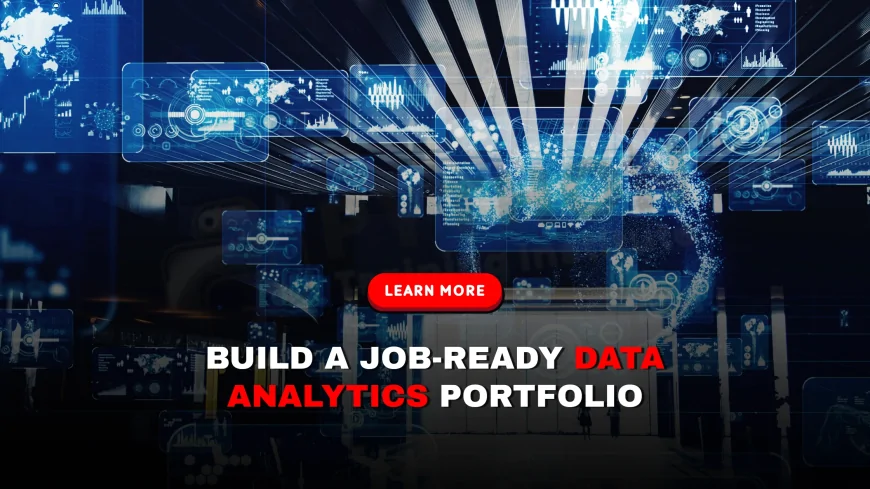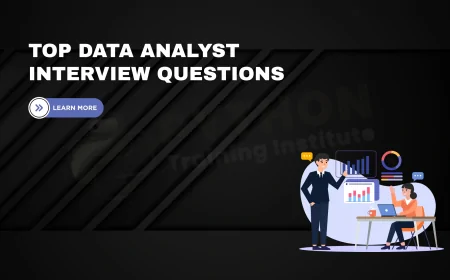How to Create a Job-Ready Data Analytics Portfolio | Data Analytics Portfolio Projects That Impress Employers
Learn how to build a job-ready data analytics portfolio with real-world projects, dashboards, and storytelling techniques to impress recruiters.

Table of Contents
- Introduction
- Why a Data Analytics Portfolio Is Crucial
- Portfolio vs Resume: What Recruiters Prefer
- What to Include in Your Data Analytics Portfolio
- Top Project Ideas to Add
- Showcasing Tools & Technologies
- Where to Get Data for Your Projects
- The Power of Storytelling with Data
- Best Platforms to Host Your Portfolio
- Using GitHub Effectively
- Building Interactive Dashboards
- Visual Design Tips for Analysts
- Creating a Case Study Format
- Common Portfolio Mistakes to Avoid
- What Hiring Managers Look For
- Keep Your Portfolio Updated
- FAQs
- Conclusion
Introduction
In today’s competitive job market, a resume alone is not enough to land a job in data analytics. What sets you apart is your portfolio — a practical showcase of your analytical skills, business thinking, and technical expertise. A job-ready data analytics portfolio gives hiring managers visual proof that you can work with data, draw insights, and communicate findings effectively. In this guide, you'll learn how to create a portfolio that gets attention — and gets you hired.
Why a Data Analytics Portfolio Is Crucial
Employers want proof. They want to see not only what you’ve learned but also how you apply it. A portfolio shows that:
- You’ve worked with real datasets
- You understand data storytelling and visualizations
- You can solve real business problems
- You’re serious about your career transition
Portfolio vs Resume: What Recruiters Prefer
While resumes list qualifications, a portfolio demonstrates value in action. Recruiters often spend more time on your GitHub or Tableau Public profile than reading your resume if your projects are well presented.
What to Include in Your Data Analytics Portfolio
- 3–5 real-world projects
- Case studies with business context, tools used, challenges, and outcomes
- Data visualizations and dashboards
- Code (Python/SQL/Excel) with comments
- Project documentation or blog write-ups
Top Project Ideas to Add
- Sales Forecasting using regression models
- Customer segmentation with clustering
- COVID-19 data trends dashboard
- Netflix dataset analysis using Python
- Survey analysis using Excel and Power BI
Showcasing Tools & Technologies
Your portfolio should clearly demonstrate your hands-on skills with:
- Data Wrangling: Python (Pandas), SQL
- Visualization: Power BI, Tableau, Matplotlib
- Analysis: Excel, Statsmodels, Scikit-learn
- Storage & Deployment: GitHub, Kaggle, Tableau Public
Where to Get Data for Your Projects
- Kaggle
- Data.gov.in
- Google Dataset Search
- UCI Machine Learning Repository
- Public APIs (e.g., OpenWeather, CoinMarketCap)
The Power of Storytelling with Data
A job-ready portfolio doesn’t just show charts. It tells a story. Always answer these:
- What was the business problem?
- What data did you use?
- What analysis did you perform?
- What did you find, and what are the insights?
Best Platforms to Host Your Portfolio
- GitHub: Host code, documentation, and Jupyter notebooks
- Tableau Public: Share interactive dashboards
- Power BI Public: Publish dashboards with business metrics
- Medium or Substack: Write blogs explaining your projects
- Personal website: Custom domain to organize everything
Using GitHub Effectively
Make your GitHub portfolio recruiter-friendly:
- Use clear repo names (e.g.,
sales-forecasting-python) - Include a
README.mdwith project summary, tools, and outcomes - Organize folders with code, visuals, and data separately
Building Interactive Dashboards
Interactive dashboards impress hiring managers and show that you can communicate insights effectively. Use:
- Power BI for corporate reporting dashboards
- Tableau for visually rich exploratory dashboards
Visual Design Tips for Analysts
Good visuals = clear thinking. Tips:
- Use contrasting colors for better readability
- Limit use of 3D or pie charts
- Highlight insights, not just trends
Creating a Case Study Format
Each project should be written like a mini case study. Format:
- Problem Statement
- Data Source
- Tool Used
- Analysis Steps
- Key Findings & Visuals
- Business Impact
Common Portfolio Mistakes to Avoid
- Using only academic datasets
- No clear explanation of project objectives
- Lack of visual storytelling or dashboards
- No links to GitHub or dashboard platforms
What Hiring Managers Look For
Companies want to see:
- Real-world problem solving
- Good data interpretation and visual communication
- Hands-on use of tools
- Consistent documentation
Keep Your Portfolio Updated
Update your portfolio regularly with:
- New tools you’ve learned
- Projects from internships or freelancing
- Blog posts explaining challenges you faced and overcame
Frequently Asked Questions (FAQs)
1. Do I need a portfolio to get a job in data analytics?
Yes, a portfolio significantly boosts your chances by showing practical skills beyond your resume.
2. How many projects should I include in my portfolio?
3 to 5 well-documented projects are sufficient to show your range and depth.
3. Can I use free datasets for my portfolio?
Absolutely! Many professionals use Kaggle, public APIs, and open government data.
4. Is GitHub enough for a data analytics portfolio?
GitHub is essential, but also use platforms like Tableau Public or a blog for full visibility.
5. What tools should I showcase?
Showcase Excel, SQL, Python, Tableau, and Power BI based on the role you're targeting.
6. Can I build a portfolio without work experience?
Yes. Use personal projects, challenges, or competitions to fill your portfolio.
7. Should I write about my projects?
Yes, writing blog posts or documentation helps explain your thought process and adds value.
8. Can I host my portfolio on LinkedIn?
Yes, you can add portfolio links to your LinkedIn featured section or about section.
9. Do employers actually check GitHub?
Yes, especially for analytics or data science roles, GitHub is often reviewed by tech recruiters.
10. What if I’m not good at design?
Focus on clarity and storytelling — clean layout, readable fonts, and concise labels matter most.
11. How can I show SQL skills?
Publish SQL queries and use platforms like Mode Analytics or Postgres in your projects.
12. Should I include Jupyter Notebooks?
Yes, include well-commented Jupyter Notebooks in your GitHub repos for Python-based analysis.
13. What are recruiters looking for in a data analytics project?
They look for data understanding, business impact, tool usage, and storytelling through visuals.
14. Can I use Excel projects in my portfolio?
Yes, especially if you're applying for entry-level analyst or MIS analyst roles.
15. Is Tableau or Power BI better for the portfolio?
Either works. Tableau is great for storytelling; Power BI is preferred in corporate environments.
16. How do I name my GitHub projects?
Use clear, descriptive names like ecommerce-sales-analysis or customer-segmentation-kmeans.
17. Should I include my learning journey?
Yes, a brief timeline or roadmap can show growth and consistency in learning.
18. Can I use Google Colab for my portfolio?
Yes, it’s easy to share and doesn’t require local setup — great for recruiters to view your code.
19. Should I use personal branding in my portfolio?
Yes! Use a consistent color scheme, name, and logo or initials to stand out.
20. How often should I update my portfolio?
At least once every 2–3 months or whenever you complete a major new project or certification.
Conclusion
Creating a job-ready data analytics portfolio is not optional — it’s essential. It tells your story, showcases your skillset, and proves to recruiters that you're ready for real-world challenges. Focus on solving real problems, documenting your approach, and presenting insights visually. Use platforms like GitHub, Tableau Public, and Medium to give your work visibility. With the right projects and a clear layout, your portfolio can become your biggest asset in landing that data analytics job you’re aiming for.
What's Your Reaction?
 Like
0
Like
0
 Dislike
0
Dislike
0
 Love
0
Love
0
 Funny
0
Funny
0
 Angry
0
Angry
0
 Sad
0
Sad
0
 Wow
0
Wow
0














